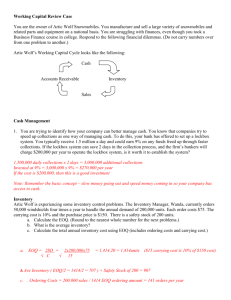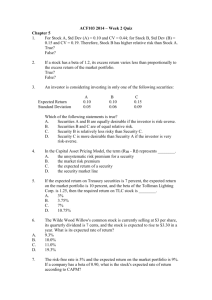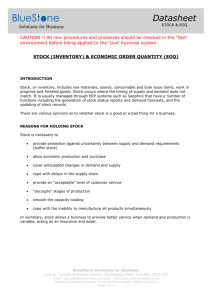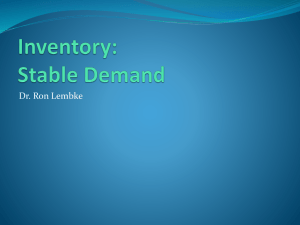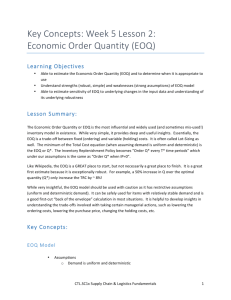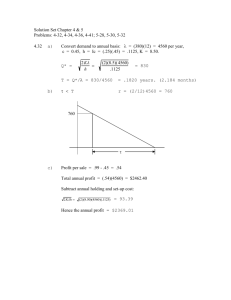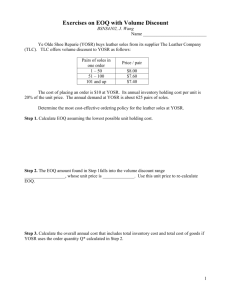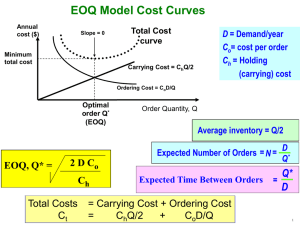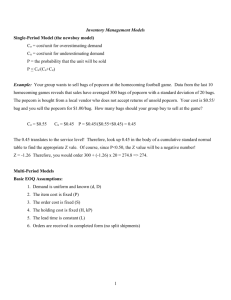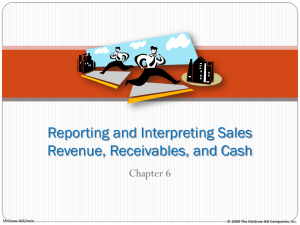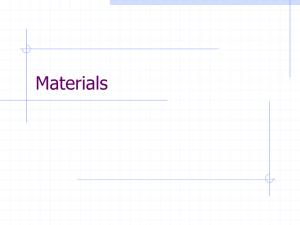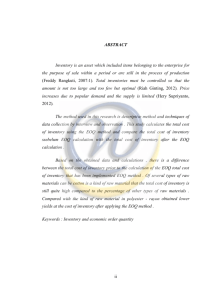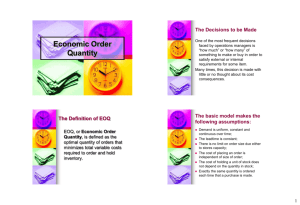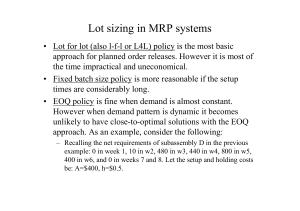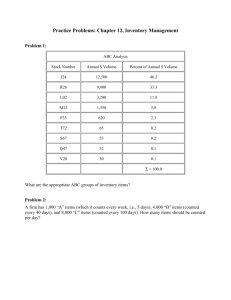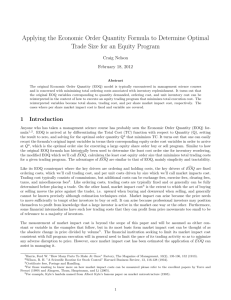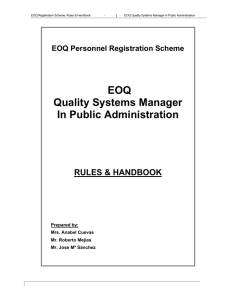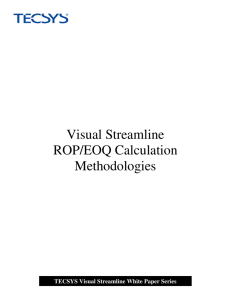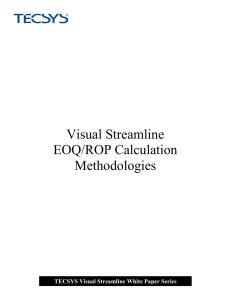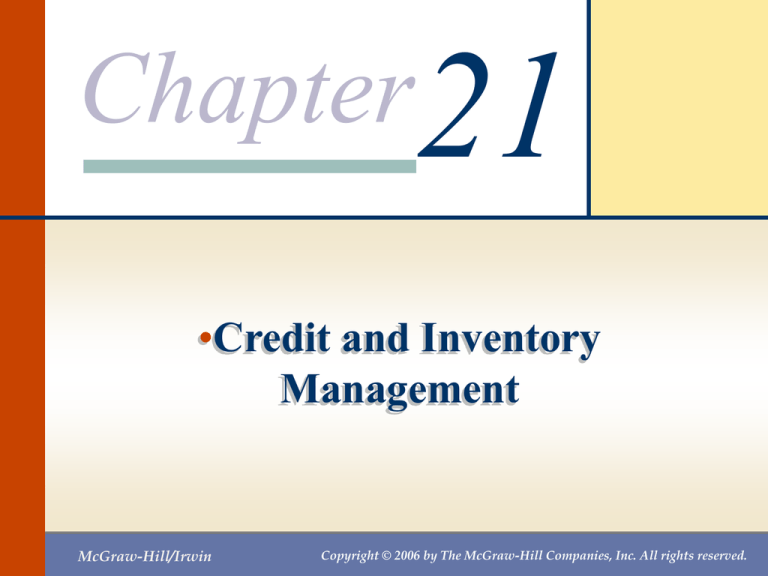
Chapter21
•Credit and Inventory
Management
McGraw-Hill/Irwin
Copyright © 2006 by The McGraw-Hill Companies, Inc. All rights reserved.
Chapter 21 – Index of Sample
Problems
•
•
•
•
•
•
•
•
•
•
Slide # 02 - 03
Slide # 04 - 06
Slide # 07 - 09
Slide # 10 - 11
Slide # 12 - 13
Slide # 14 - 15
Slide # 16 - 21
Slide # 22 - 25
Slide # 26 - 27
Slide # 28 - 30
Accounts receivable
Discount terms
Credit policy switch
Switch break-even point
One-time sale
Repeat sale
Economic order quantity (EOQ)
One-shot approach
Accounts receivable approach
Discounts and default risk
2: Accounts receivable
Over the past five years, your firm has had average daily sales of
$26,780. The average collection period is 34 days.
What is the average accounts receivable balance you would expect
to find if you analyzed the monthly balance sheets of your firm?
3: Accounts receivable
Averageaccountsreceivable Averagedaily sales Averagecollectionperiod
$26,780 34
$910,520
4: Discount terms
Today, June 10, you purchased $5,000 worth of materials from one
of your suppliers. The terms of the sale are 3/15, net 45.
What is the discounted price?
By what day do you have to pay to receive the discount?
What is the effective annual rate of the discount?
5: Discount terms
Discountedprice $5,000 (1- .03)
$5,000 .97
$4,850
Final day for discount June 10 15 days June 25
6: Discount terms
Daysin period 45 - 15 30
Periods per year
365
12.1667
30
.03 $5,000
Interestratefor 30 days
(1- .03) $5,000
$150
$4,850
.03093
Effectiveannualrate (1 .03093)12.1667 1
.44862
44.86%
7: Credit policy switch
Currently, your firm has a cash only policy. Under this policy, your
monthly sales are 70 units at a selling price of $50 a unit. The variable cost
is $34 a unit. You are trying to decide if you want to change your credit
policy to net 30. You estimate that if you switch your credit policy that
your monthly sales will increase to 90 units. The applicable monthly
interest rate is .5%.
What is the incremental cash inflow from the proposed switch in your
credit policy?
What is the net present value of the proposed switch?
8: Credit policy switch
Incrementa
l cash inflow (P - v)(Q'-Q)
($50 $34)(90 70)
$16 20
$320
9: Credit policy switch
(P v)(Q'Q)
NP V [(P Q v(Q'Q)]
R
($50 $34) (90 70)
[($50 70) $34 (90 70)]
.005
$320
[$3500 $680]
.005
$4,180 $64,000
$59,820
10: Switch break-even point
Your brother owns a company that also has a cash only credit
policy. He, too, is considering switching to a net 30 credit
policy. His current sales per month are 85 units at an average
selling price of $60 a unit. His variable cost is $42 a unit. His
applicable monthly interest rate is 1.5%.
Your brother wants to know how many additional units he
would have to sell to break-even on this proposed credit
policy switch. What should you tell him?
11: Switch break-even point
Pv
Q'Q P Q
v
R
$60 $42
Q'85 ($60 85)
$42
.015
Q'85 $5,100 ($1,200 $42)
Q'85 $5,100 $1,158
Q'85 4.404
12: One-time sale
A customer just walked into your store and wants to buy some
electronics costing $89. The customer states that he is from out of
town and is just passing through on an extended vacation. Thus,
you know that this is a one-time sale. Your variable cost for this
merchandise is $50 and your relevant interest rate is 1.5% per
month. Since this customer had not planned on making this
purchase, he does not have sufficient funds with him to pay for it
and thus asks for credit for one month until he arrives back home.
Should you grant credit to this customer if you feel there is a 30%
chance that he will default?
13: One-time sale
P
NPV v (1 )
1 R
$50 (1 .30) $89
1 .015
$50 (.7 $87.68)
$50 $61.38
$11.38
14: Repeat sale
A new customer just walked into your store. She says that she is
new to the area and is out checking out the various retail stores to
decide where she will shop in the future. She’s looking at some
merchandise costing $250 but states that she won’t have that
much money until next month. You know that your variable cost in
the item is $180 and that your monthly interest rate is 1.7%.
Should you offer her credit for one month if you feel that the
chance of default is 10%?
15: Repeat sale
Pv
NP V v (1 )
R
$250 $180
$180 (1 .10)
.017
$180 (.90 $4,117.647)
$180 $3,705.88
$3,525.88
16: Economic Order Quantity (EOQ)
You have just accepted a job as the purchasing manager for a local
retailer. You have identified one key item that you believe needs
close monitoring. You’ve been told that your store sells 31,200
units of this item each year. The fixed costs per order are $75. The
carrying cost per unit is $1.10.
What is the economic order quantity?
17: Economic Order Quantity (EOQ)
EOQ
2T F
CC
2 31,200 $75
$1.10
$4,680,000
$1.10
4,254,545.46
2,062.65 unit s
18: Economic Order Quantity (EOQ)
You sell 12,000 units of a product each year at an average price of
$15 each. Your variable cost per unit is $9. Your carrying cost per
unit is $.60. You allow your inventory of this product to drop to
zero before restocking. Each order you place is for 2,500 units. The
fixed cost per order is $40.
What is your annual total carrying cost?
What is your annual total restocking cost?
What is the EOQ?
19: Economic Order Quantity (EOQ)
T otalcarryingcost Averageinventory Carryingcost per unit
2,500 0
$.60
2
1,250 $.60
$750
12,000
$40
2,500
4.8 $40
$192.00
T otalrestockingcost
20: Economic Order Quantity (EOQ)
EOQ
2T F
CC
2 12,000 $40
$.60
$960,000
$.60
1,600,000
1,264.91
21: Economic Order Quantity (EOQ)
T ot alcarryingcost Averageinvent ory Carryingcost per unit
1,264.91 0
$.60
2
632.455 $.60
$379.47
12,000
$40
1,264.91
9.48684 $40
$379.47
T otalrestockingcost
22: One-shot approach
Your firm currently sells 200 units each month at a price of $24
each. The variable cost per unit is $14 and the monthly interest
rate is 1.5%. If you switch your credit policy from cash only to net
30, you think you can increase your sales to 215 units a month.
Use the one-shot approach to compute the NPV of the switch.
23: One-shot approach
Current net income (P - v) Q
($24- $14) 200
$2,000
24: One-shot approach
Proposed income P Q'
$24 215
$5,160
Proposedcost v Q'
$14 215
$3,010
$5,160
P roposedNP V - $3,010
1 .015
$3,010 $5,083.74
$2,073.74
25: One-shot approach
Mont hlygain fromswit ch $2,073.74- $2,000
$73.74
NPV of switch $73.74 $73.74
.015
$4,989.74
$4,990
26: Accounts receivable approach
Your firm currently sells 200 units each month at a price of $24
each. The variable cost per unit is $14 and the monthly interest
rate is 1.5%. If you switch your credit policy from cash only to net
30, you think you can increase your sales to 215 units a month.
Use the accounts receivables approach to compute the NPV of the
switch.
27: Accounts receivable approach
(P v)(Q'Q) {[ P Q v(Q'Q)] R}
R
[($24 $14) (215 200)] {[($24 200) $14 (215 200)] .015}
.015
[$1015] {[$4,800 $210] .015}
.015
$150 $75.15
.015
$74.85
.015
$4,990
PV
28: Discounts and default risk
Currently, you sell 50 units per period at $22.50 a unit. You are
considering implementing a net 30 credit policy along with
increasing your credit price to $24. If you make this change, you
expect that your sales will remain at their current level. You also
expect all of your customers to take advantage of the credit period
and that 2% of them will default. The applicable monthly interest
rate is 1.5%.
What is the net present value of this proposed credit policy?
What is the break-even default rate?
29: Discounts and default risk
P' P
P'
$24.00 $22.50
$24.00
.0625
6.25%
d
d
NP V P Q P' Q
R
($22.50 50) ($24 50)
$1,125 $3,400
$2,275
.0625 .02
.015
30: Discounts and default risk
d R (1 d )
.0625 .015 (1 .0625)
.0625 .0141
.0484
4.84%
Chapter21
•End of Chapter 21
McGraw-Hill/Irwin
Copyright © 2006 by The McGraw-Hill Companies, Inc. All rights reserved.

